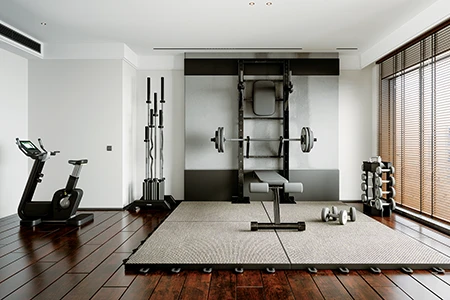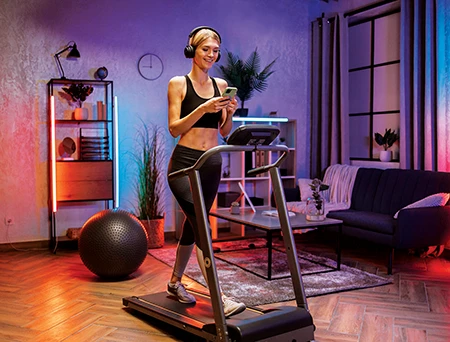Achieving and maintaining a healthy fitness foundation helps you safely enjoy diving. Time and money are the most common barriers to regular exercise, so a home gym can be a practical and cost-effective solution for fitting workouts into your busy schedule. It eliminates a commute to the gym and membership fees.
Follow these simple steps to set up a well-equipped, cost-effective home gym that meets your needs.
1. Identify general fitness goals.
Are you focused on strength training, cardio, flexibility, or a combination of these? Understanding your goals will help you choose the right equipment. You will need heavier weights to focus on strength and power, but you can start with lighter weights for toning and endurance.
2. Assess your space.
Whether it’s a spare room, garage, or corner of your living room, the space will dictate the type and amount of equipment you can accommodate. Ensure sufficient height clearance for overhead lifts and pull-ups if considering a rack. For a wall-mounted rack, ensure the wall can support it and that there are no obstructions. Measure the floor space where you’ll place the equipment, accounting for additional space needed for movement.Consider your structure’s weight limits. For example, heavy equipment is best for a ground floor or garage. Make sure that anything you install is connected to a structurally sound location.
3. Create a motivating environment.
A welcoming and motivating home gym can significantly impact your workout routine.Consider rubber mats or foam tiles for the floor to reduce joint stress. Monitor any moisture that may develop under rubber mats to prevent mold growth. The year-round temperature and ventilation for the space are important, as is having a well-lit environment. Natural light is best, but otherwise invest in good artificial lighting. Adding mirrors can make your space feel larger and help you maintain proper form during exercises. A good set of speakers or a Bluetooth sound system for your favorite workout tunes is a great addition.

4. Consider recommended equipment.
Focus on the basics that align with your fitness goals instead of buying every piece of equipment you see. Here are some versatile yet budget- and space-friendly options.
Power rack:A rack is a versatile foundation for a home gym, so consider one if you have the space. It supports a wide range of exercises for the whole body and requires little or no maintenance. Consider the rack’s weight capacity to make sure it aligns with your current and future fitness goals. A power rack is ideal, but wall-mounted folding or half-racks are available if space is an issue. You should plan for at least 2 feet (0.6 meters) of clearance on all sides of a power rack.

A power rack can range from $500 to $3,000 depending on weight capacity and features. Quality racks are usually 11- or 12-gauge steel. You might find a bargain at a gym’s going-out-of-business or moving sale or with other secondhand options. If you purchase a used rack, inspect the welds and ensure there isn’t rust. Some features to look for include stability with no wobble, spotter arms to catch the barbell if you drop it, J-hooks to facilitate various exercises, and a pull-up bar and other attachment options.
Adjustable or flat bench: An adjustable bench offers versatility for different exercises but may cost between $150 and $1,500. Flat benches are slightly less versatile, but you can find a solid one for less than $200. Whichever you choose, ensure it is sturdy and stable.
Weight set with barbell, dumbbells, or kettlebells: You may eventually want all three types of weights, but you only need one to get started. Adjustable dumbbells are cost-effective and take up minimal space. Kettlebells are useful for both strength and cardio workouts. For a weight set with a barbell, make sure the barbell’s capacity and weight are sufficient. Rubber or rubber-coated plates may be more expensive but are quieter and can reduce injury and floor damage when dropped. You can start with a few weights and get more sizes over time. The costs vary significantly depending on weight, but these components are usually durable and available secondhand.
Additional equipment:Resistance bands are inexpensive, take up minimal space, and are very versatile. Sets range from $20 to $80. Colors indicate the resistance but vary by brand. Bands wear out over time, so purchase them new. Jump ropes are cheap and easy to store, but you will need overhead clearance and space around you to jump indoors. Yoga mats are great for floor exercises, stretching, and yoga. Mats are affordable, so purchase them new for cleanliness and because they wear out over time. Stability balls are excellent for core workouts and improving balance, and you can use them with dumbbells in place of a bench. They can also double as desk chairs.
If you have the space and budget, consider adding a cardio machine such as a treadmill, stationary bike, or rowing machine. A quality machine can be expensive but is vital to a positive experience. Maintenance of this equipment is important.

Setting up a home gym on a budget by prioritizing essential equipment, shopping smart, being thoughtful about your space, and creating a motivating environment can help you integrate daily exercise into your life. Safety should always be a top priority. Your home gym space should be organized and free of hazards. Ensure your equipment is properly installed and maintained for a safe and fun workout.
NOTE: To avoid an increased risk of decompression sickness, DAN® recommends that divers avoid strenuous exercise for 24 hours after making a dive. During your annual physical exam or following any changes in your health status, consult your physician to ensure you have medical clearance to dive.
© Alert Diver – Q3 2024